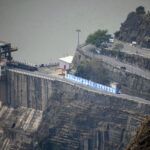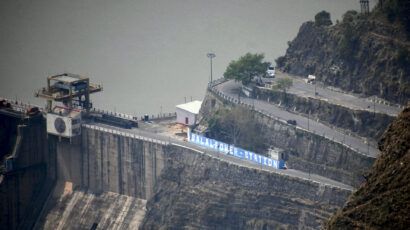Trinity, in haiku
By Charles Trumbull | April 17, 2014

Human history changed in a flash on July 16, 1945, with the first explosion of an atomic bomb, which took place at the Trinity Site, a remote stretch of desert at the north end of the Jornada del Muerto (“Day’s Journey of the Dead Man”) in the Tularosa Basin east of Socorro, N.M. Located on the territory of White Sands Missile Range, the Trinity Site is closed to the public all but two days a year. Driving to the site proper, we pass through a guarded main gate and proceed several miles south. About an acre of land around ground zero, simply a three-foot-deep declivity with a small basalt obelisk marking the spot, is cordoned off with chain-link fencing. Photographs from 1944–45 are hung museum-style along the fence.
The McDonald Ranch, about three-quarters of a mile from ground zero, served as the headquarters and observation point for the scientists from Los Alamos who developed the atomic device. On display in the ranch house is a facsimile of Albert Einstein’s letter of Aug. 2, 1939, to President Franklin D. Roosevelt advising him of the scientific feasibility of making an atomic bomb and warning him of a growing interest in the development of uranium in Nazi Germany. A model of “Fat Man,” the bomb dropped on Nagasaki, is on display at the Trinity Site. (The first bomb, “Little Boy,” was detonated over Hiroshima.) Trinitite is the name given to the green glass-like mineral fused from sand by the intense heat of the atomic blast.
Sixty-five-plus years on, we contemplate how this event, the apotheosis of modern science, instantaneously shifted the political, economic, military, and especially moral landscape of the modern world. J. Robert Oppenheimer, chief scientist on the Manhattan Project, famously quoted a line from the Bhagavad Gita: “Now I am become Death, the destroyer of worlds.”
This haiku sequence records, journal-style, impressions from a visit to the Trinity Site in October 2011.
October dawn
a fireball rises
over the mountain
Jornada del Muerto
autumn morning haze
fills the valley
looking for antelope
along the roadside—
DANGER signs
Trinity Site
in the guard’s vehicle
fuzzy dice
we drive through the gate
feeling very American—
weeds through asphalt
small talk
“my father
was at Oak Ridge …”
squabbling children—
the grasshopper
hops away
ground zero
we walk into a depression
decades old
black lava obelisk
like a tombstone
marks the spot
everyone wonders
about lingering radiation—
rattle of a locust
65 years:
the persistence
of trinitite
scraping the dirt
with my toe—
a grain of green glass
Trinity’s garden:
snakeweed, Russian thistle,
yucca, sagebrush
Porta Potty
someone has scrawled
“Army”
visitors gawk
at souvenir mugs, hats, T-shirts, …
Fat Man
the Stars and Stripes stretched tight across a tourist’s breasts
McDonald Ranch silence shattered by two sonic booms
“clean room”
at the ranch house
the Einstein letter
empty magpie nest in a mesquite bush
we leave the site
in the malpaís
sand shifts slowly
Editor's note: This version was originally published in Frogpond 35:3 (Autumn 2012).
Together, we make the world safer.
The Bulletin elevates expert voices above the noise. But as an independent nonprofit organization, our operations depend on the support of readers like you. Help us continue to deliver quality journalism that holds leaders accountable. Your support of our work at any level is important. In return, we promise our coverage will be understandable, influential, vigilant, solution-oriented, and fair-minded. Together we can make a difference.
Topics: Analysis, Nuclear Weapons















